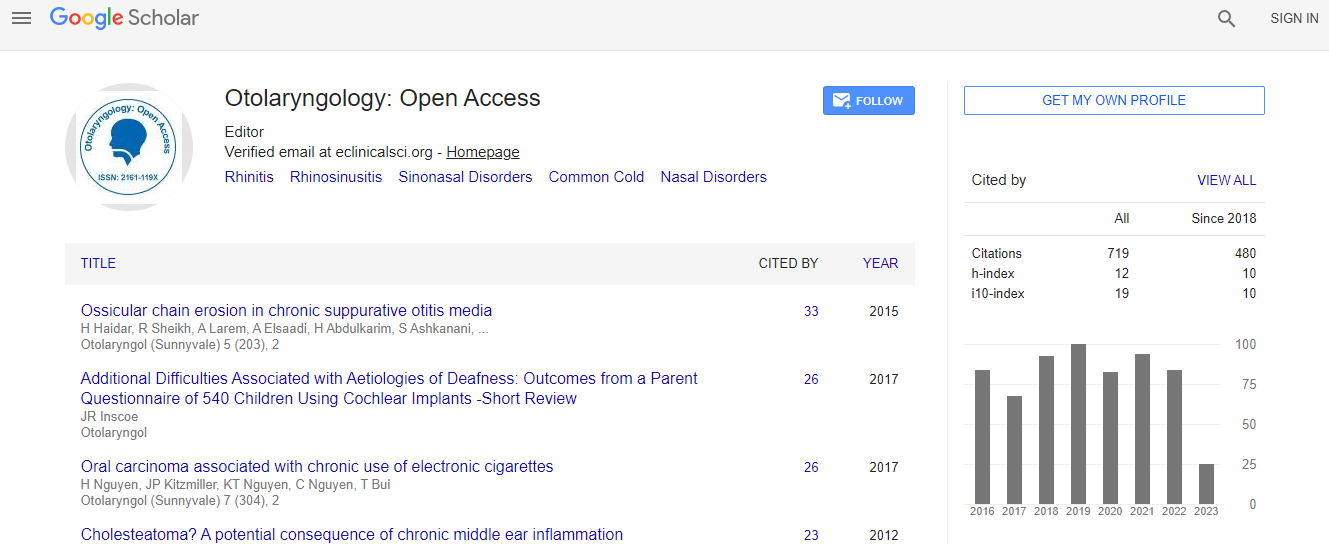Our Group organises 3000+ Global Conferenceseries Events every year across USA, Europe & Asia with support from 1000 more scientific Societies and Publishes 700+ Open Access Journals which contains over 50000 eminent personalities, reputed scientists as editorial board members.
Open Access Journals gaining more Readers and Citations
700 Journals and 15,000,000 Readers Each Journal is getting 25,000+ Readers
Google Scholar citation report
Citations : 925
Otolaryngology: Open Access received 925 citations as per Google Scholar report
Otolaryngology: Open Access peer review process verified at publons
Indexed In
- Index Copernicus
- Google Scholar
- Sherpa Romeo
- Open J Gate
- Genamics JournalSeek
- RefSeek
- Hamdard University
- EBSCO A-Z
- OCLC- WorldCat
- Publons
- Geneva Foundation for Medical Education and Research
- ICMJE
Useful Links
Recommended Journals
Related Subjects
Share This Page
The series of island skin flaps applied in head and neck reconstruction
Global Summit and Medicare Expo on Head & Neck Surgery
Xiaohong Chen
Beijing Tongren Hospital, China
ScientificTracks Abstracts: Otolaryngol (Sunnyvale)
Abstract
Background & Purpose: A series of head and neck skin flaps were harvested to maximize the function of the donor area and minimize the complications of the recipient area. Material & Methods: With the help of by digital subtraction angiography (DSA) of the responsible vessel in the perforator for surface markers or preoperative vascular ultrasound positioning has completed in 45 cases of island pectoralis major myocutaneous flap, 11 cases of mammary perforator island flap, 3 cases of lower trapezius island flap, 2 cases in sternocleidomastoid myocutaneous island flap, 3 cases of transverse cervical vessels of superficial flap and 3 cases of thoracoacromial artery perforator flap. In addition, such conventional island flap is modified including 16 cases of submental flap, 8 cases of frontal flap island flap. The diseases in the recipient site included primary or recurrent pharyngeal and laryngeal cancer and tonsil carcinoma, soft palate tumor, tongue reconstruction of total glossectomy, maxillary sinus carcinomaases, recurrent ethmoid maxillary sinus carcinoma, gingival carcinoma, cervicahypopharyngeal and cervical esophageal stenosis, base of tongue cancer, external nose neoplasm postoperative defect anterior cervical skin defect, tracheoesophageal fistula, post burn scar hypopharyngeal stenosis, cervical vertebra trauma pharyngeal fistula Behcet�s disease, anterior wall defect, the fistula recurrence carcinoma. Results: Eight cases presented postoperative pharyngeal fistula and were cured after local dressing. Two cases were failed, including 1 case with the vascular pedicle damaged when isolated, 1 case with broken vascular pedicle when transferring the flap to the maxillary defect. Two cases presented partial flap necrosis 1 cm*2 cm necrosis of skin and recovered after local dressing. The retention of shoulder joint was good and the upper arm function was normal and the figure of upper part of the chest was better in all the island PMMF patients. Conclusion: The island flap is minimally invasive design, not only less injury combined better figure in the donor site but also less complications and a further transfer distance in the recipient site, but it needs a high surgical technique.Biography
Xiaohong Chen is MD and a Professor. In 2005, he has obtained his ENT Doctor degree and he has worked as Post-doctor in UCLA from 2009-2010. He is the Vice- Director of Otolaryngology, Head and Neck Surgery Department in Beijing Tongren Hospital, Capital Medical University, China. He is a Member of the Committee of Beijing Anticancer Association and the Commission of Chinese Anti-Cancer Association and Melanoma Committee. He is an expert in diagnosis and treatment on rare diseases of head and neck, operation design for maintaining function of important organs and cosmetic result of incision design in head and neck tumor surgery, retention function of eye of the patients with the malignant nasal cavity and paranasal sinus tumor, salvage or radical surgery for advanced tumor of head and neck and familial hereditary tumor.
Email: trchxh@163.com

 Spanish
Spanish  Chinese
Chinese  Russian
Russian  German
German  French
French  Japanese
Japanese  Portuguese
Portuguese  Hindi
Hindi 
